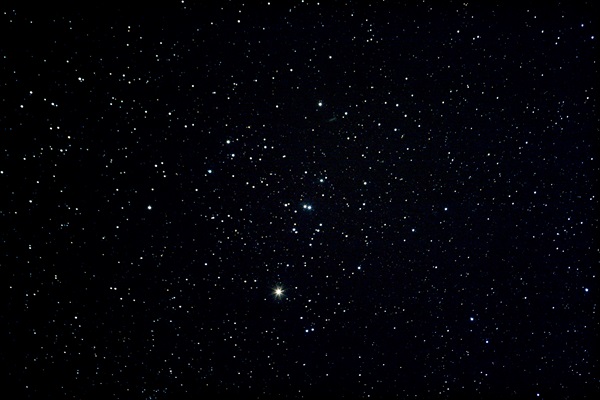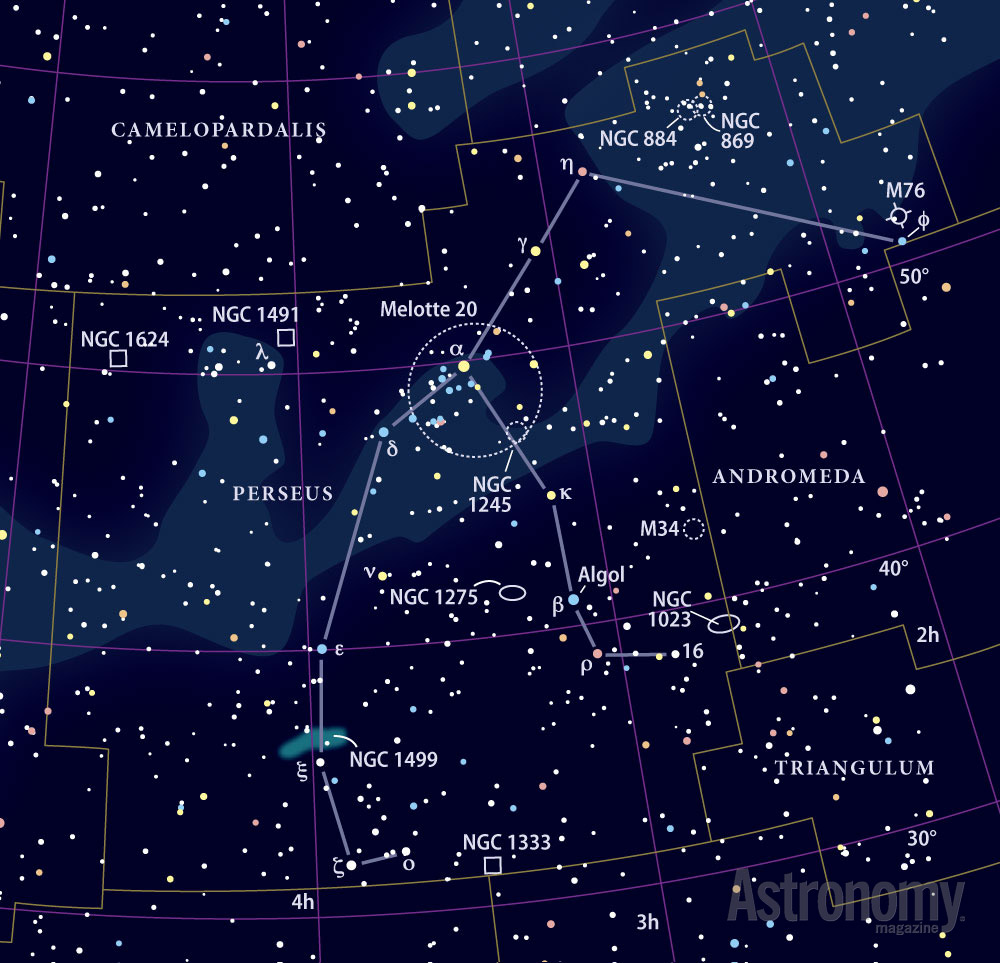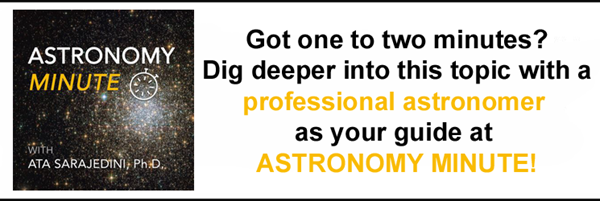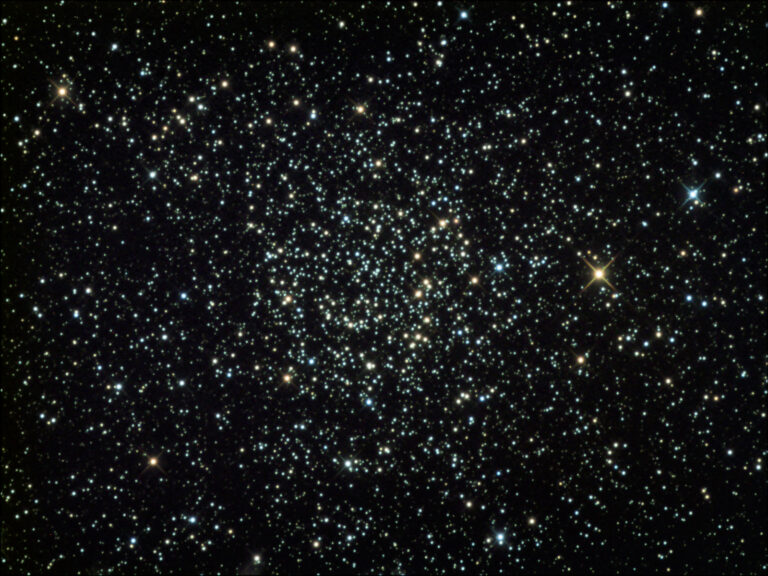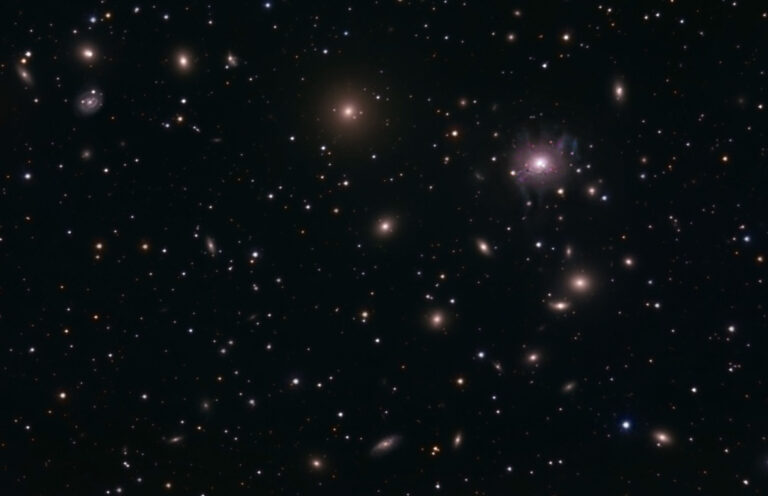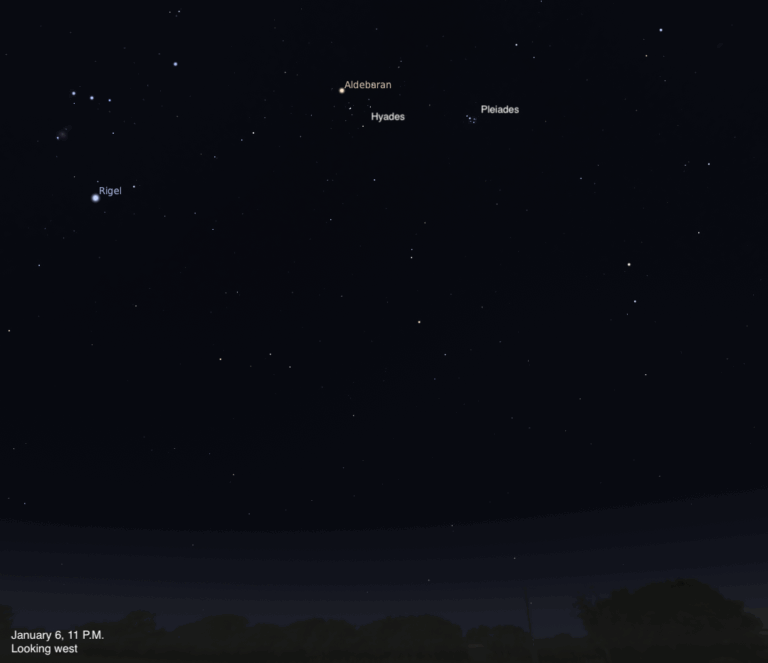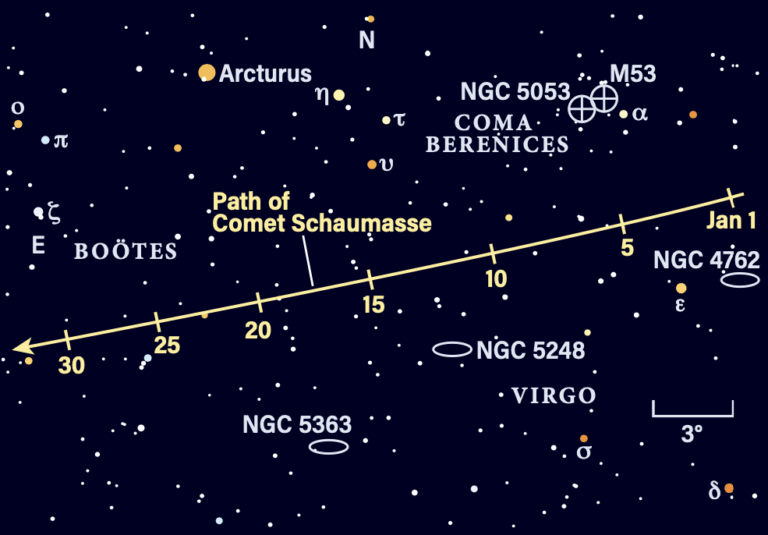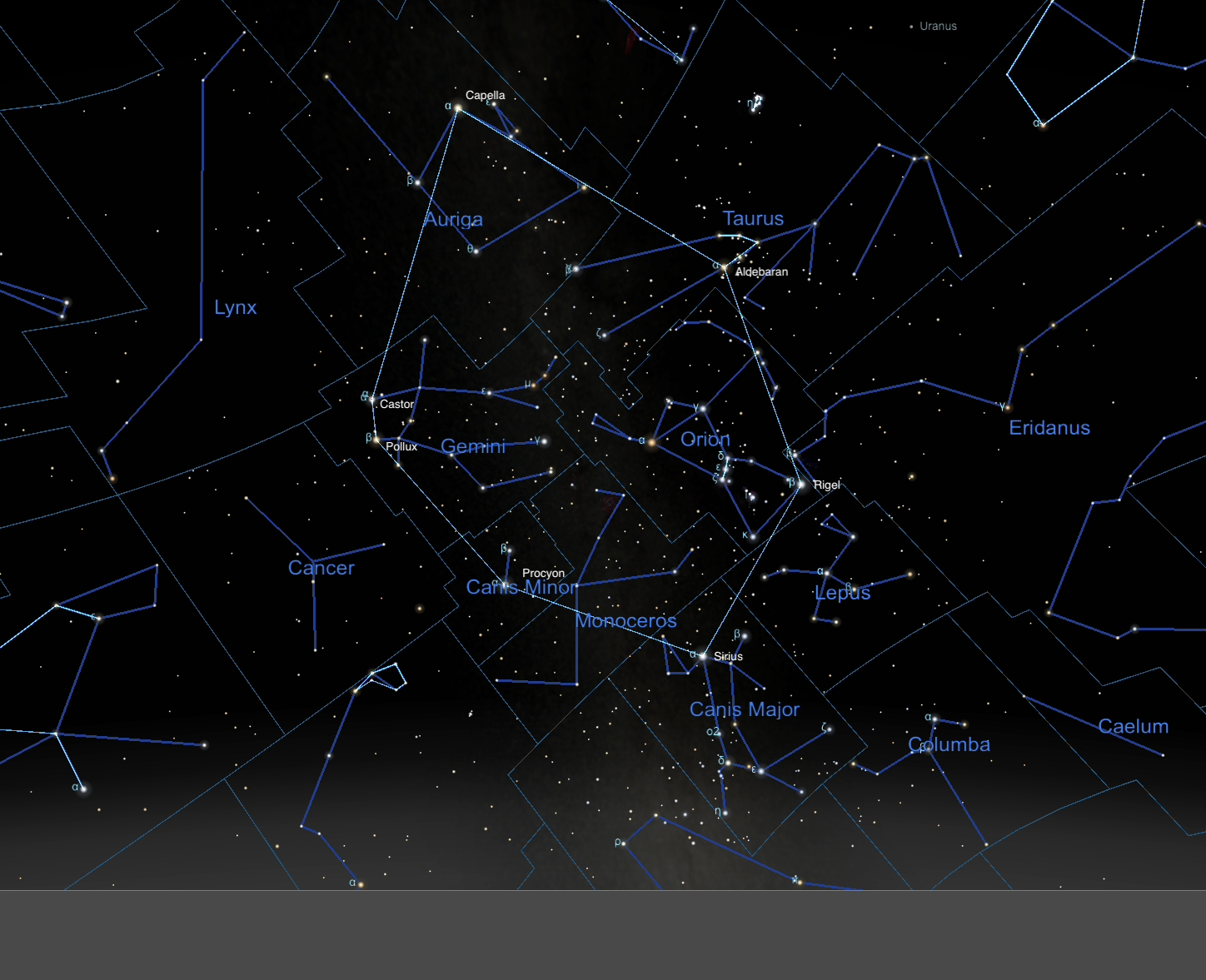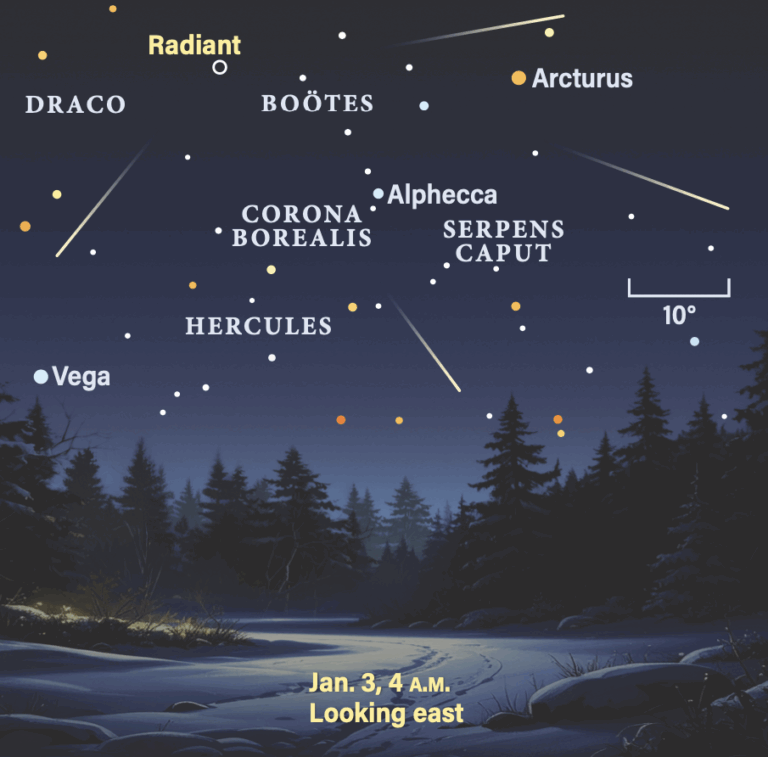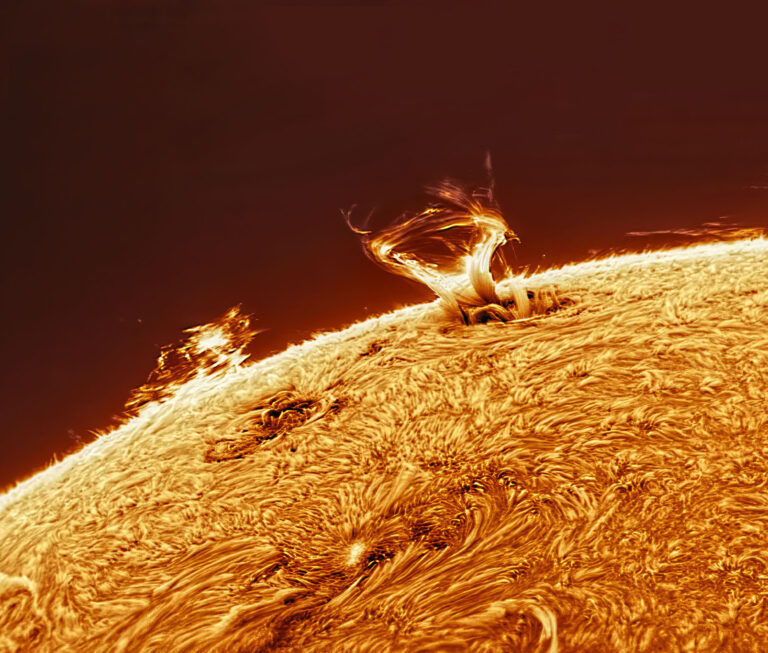Key Takeaways:
Friday, November 26
Dwarf planet 1 Ceres is at opposition tonight at 11 P.M. EST. It’s visible all evening, located amid the stars of the Hyades, situated on the nose of Taurus the Bull. His bright red eye, Aldebaran, can guide you: Ceres sits 5° due west of this 1st-magnitude star. The dwarf planet glows at magnitude 7.7, reachable with binoculars or a small telescope.
But while you’re searching out this single point of light, take some time to enjoy its surroundings as well. The Hyades is a young cluster about 150 light-years away and its stars are about 625 million years old. Although Aldebaran sits near the loosely scattered Hyades, it is not part of the cluster. Aldebaran is an aging red giant star nearly 70 light-years away. It’s the 14th-brightest star in the sky and stretches out to some 43 times the distance of the Sun’s diameter. If it sat in the center of our own solar system, it would take up a huge 20° in the sky from Earth. The Sun takes up a mere 0.5° (the same size as the Full Moon).
Sunrise: 6:58 A.M.
Sunset: 4:37 P.M.
Moonrise: 11:02 P.M.
Moonset: 12:38 P.M.
Moon Phase: Waning gibbous (58%)
*Times for sunrise, sunset, moonrise, and moonset are given in local time from 40° N 90° W. The Moon’s illumination is given at 12 P.M. local time from the same location.
Saturday, November 27
Last Quarter Moon occurs at 7:28 A.M. EST this morning. One of the best things about the Moon is that you can see it even with the Sun in the sky. At sunrise, the Moon is high in the south, located in Leo the Lion. It won’t set until after noon. Consider taking a little time during or after your morning routine to gaze at our satellite against the blue backdrop of the daytime sky.
Of course, if you observe before dawn, you’ll certainly get more detail. Plus, it’s easy to train binoculars or a telescope on the bright lunar face. Some of the most noticeable features on the Last Quarter Moon are the vast Mare Imbrium, bordered to the east by the rugged Apennine Mountains, with the large crater Copernicus below it. Running in a line down the center of our satellite near the terminator are the craters Herschel, Ptolemaeus, Alphonsus, and Arzachel. The large crater Clavius, famous for a curve of several smaller craterlets within it, is the highlight of the lunar south.
Sunrise: 6:59 A.M.
Sunset: 4:36 P.M.
Moonrise: —
Moonset: 1:07 P.M.
Moon Phase: Waning crescent (48%)
Sunday, November 28
Let’s spend tonight in Cetus the Whale, rising in the East as the Sun sets. Let the constellation climb a bit higher, then pull out binoculars or a telescope to track down M77, a beautiful face-on spiral galaxy.
To locate M77, first find magnitude 4.1 Delta Ceti, which sits just south of the Cetus’ Head asterism. M77 is a bit less than 1° east-southeast of this star. At 9th magnitude, even small binoculars will show it, although larger lenses (50 millimeters or greater) are better. Through binoculars, you’ll catch M77 as a dim, oval-shaped glow. With a telescope and higher magnification, you may begin to make out its dimmer spiral arms. The galaxy spans roughly 7′ by 6′ on the sky and sits between 50 million and 60 million light-years away. The bright core of this galaxy is extremely energetic, which astronomers believe is due to an actively feeding supermassive black hole some 10 million times the mass of our Sun.
Asteroid 4 Vesta is in conjunction with the Sun at 5 A.M. EST, while Mercury reaches superior conjunction at midnight EST tonight. The small planet will slip out of the Sun’s glare and into the evening sky in late December.
Sunrise: 7:00 A.M.
Sunset: 4:36 P.M.
Moonrise: 12:08 A.M.
Moonset: 1:34 P.M.
Moon Phase: Waning crescent (37%)
Monday, November 29
The early-morning hours between midnight and sunrise are the best time to observe Comet 67P/Churyumov-Gerasimenko as it skims through Cancer the Crab. Currently about 9th magnitude, this periodic comet is less than 7.5° north of the center of the Beehive Cluster (M44) tonight. Recent observations have reported a coma diameter of about 5′.
M44 is a scattered open cluster visible to the naked eye at magnitude 3.7, spanning about 1.5°. Also called Praesepe, or the Manger, ancient Greeks and Romans saw it as the outline of this namesake structure in the sky. It contains about 350 stars between 500 and 600 light-years away, all of which are roughly 730 million years old. Researchers think that this cluster and the Hyades in Taurus may have the same origin, despite their disparate locations today.
Sunrise: 7:01 A.M.
Sunset: 4:36 P.M.
Moonrise: 1:15 A.M.
Moonset: 1:59 P.M.
Moon Phase: Waning crescent (27%)
Tuesday, November 30
Venus, Saturn, and Jupiter are still lined up nicely in the evening sky, visible for at least two hours after the Sun disappears. It’s hard to miss them — particularly Venus, which is blazing a bright magnitude –4.9 amid the stars of Sagittarius the Archer. Just over 18° to Venus’ east is Saturn, a much dimmer magnitude 0.6 against the backdrop of Capricornus. And simply look 16.5° east of Saturn to spot Jupiter, shining at magnitude –2.3. It now sits slightly more than 2° northeast of the star Deneb Algedi.
Venus is the first to set, so let’s focus on it first as well. Its disk currently spans some 39″ and is a little less than 30 percent lit. We see Venus go through phases — just like the Moon — because it is closer to the Sun than Earth. The surface itself is shrouded in a thick atmosphere of toxic gases, so images through a telescope typically show little detail from these cloud tops.
Saturn, which appears 16″ across, is flanked by its magnificent ring system, stretching 35″ across. Titan, the largest and brightest of its moons, is often apparent in binoculars or a telescope. It sits about 52″ south of the planet tonight.
Jupiter appears 38″ across and, depending on when you pick it up in the darkening sky, may be undergoing a transit as the icy moon Ganymede crosses its face. The transit starts before dark in the eastern US and continues until just before 8:30 P.M. EST, when the planet is still well above the horizon. Ganymede’s large shadow slips onto the disk just after 10 P.M. EST and takes more than three hours to cross it.
Once it exits the disk to the planet’s west, Ganymede joins Io (next in line from the planet) and Europa and Callisto. Once again, timing is everything — around 7:44 P.M. EST, Europa appears 7.5″ south of Callisto as it “overtakes” the more distant moon, moving from east to west. So, before this time, Europa appears closer to Jupiter than Callisto. Afterward, it is the last moon out in the line of four.
Sunrise: 7:02 A.M.
Sunset: 4:35 P.M.
Moonrise: 2:24 A.M.
Moonset: 2:25 P.M.
Moon Phase: Waning crescent (18%)
Wednesday, December 1
Planet Neptune is stationary against the background stars at 5 P.M. EST. Floating in Aquarius the Water-bearer, you’ll find the solar system’s most distant planet already 40° high an hour after sunset. You’ll need binoculars or a small scope to spot the magnitude 7.7 planet, which spans a mere 2″ on the sky. Neptune’s diminutive size is due to its distance, as it currently sits roughly 2.8 billion miles (4.5 billion kilometers) from Earth.
To locate the planet, first find 4th-magnitude Phi (φ) Aquarii, then look 3° east-northeast for a small, “flat” star that glows a dull gray-blue. That’s Neptune. During November, the planet was moving southwest, inching closer to Phi. Now, it will reverse course, sliding northeast and slowly increasing its distance from the star.
Sunrise: 7:03 A.M.
Sunset: 4:35 P.M.
Moonrise: 3:37 A.M.
Moonset: 2:53 P.M.
Moon Phase: Waning crescent (10%)
Thursday December 2
This morning, step outside just before sunrise to catch sight of Mars and the thin crescent Moon about 6° apart. Our Moon is a barely illuminated 5 percent lit, while Mars glows a soft magnitude 1.6. The Red Planet currently spans 4″ on the sky and sits in Libra. If you catch the pair about an hour before sunrise, when the brighter stars are still visible, you’ll see that our satellite sits close to magnitude 2.8 Zubenelgenubi, the constellation’s alpha star. Mars lies within 2.5° of 4th-magnitude Iota (ι) Librae, and is 8.8° due south of Zubenesch, Libra’s magnitude 2.6 beta star.
Later today, while both are below the horizon, the Moon passes 0.7° north of Mars at 7 P.M. EST. By tomorrow morning, it will be just over 8° east of Mars, having crossed the border into Scorpius and nearing the Sun.
Sunrise: 7:04 A.M.
Sunset: 4:35 P.M.
Moonrise: 4:53 A.M.
Moonset: 3:27 P.M.
Moon Phase: Waning crescent (4%)
Friday, December 3
It’s time to hunt down the American Association of Variable Star Observers’ final featured variable star for the year: Algol. Also called the Demon Star, Algol (cataloged as Beta Persei), sits within Perseus the Hero. It’s already nearly 49° high in the northeast an hour after sunset and still climbing.
Algol is an eclipsing binary system in which one component crosses in front of the other from our point of view, dimming its magnitude predictably every 2.867 days. This takes the star from magnitude 2.1 at its brightest to magnitude 3.4 — 70 percent dimmer — and is noticeable to the naked eye. To determine where the star is in this cycle, compare it to nearby Mirfak (Alpha [α] Persei), which is a steady magnitude 1.8. At its brightest, Algol is roughly as bright as Mirfak; at its dimmest, it is noticeably fainter than the alpha star.
In addition to its well-charted variability, Algol has a second claim to fame: Its more massive component (3.5 times the mass of our Sun) appears less evolved (earlier in its life cycle) than its less massive component, which is dying star weighing in at a mere 0.81 solar mass. This gave rise to the famous so-called Algol paradox, because more massive stars evolve and age more quickly than less massive stars. So, how could the less-massive star have evolved quicker than its more massive counterpart in this case?
The truth is that it didn’t: Instead, the less-massive star is only less massive today because it’s lost so much of its mass to its companion star, which has beefed up its own mass by sucking material away from its partner. So, the star that started out more massive has truly evolved faster, but simply lost most of its mass over time.
Although the eclipsing binary component of this system is the cause of its variability, Algol does contain at least one more star, which orbits the eclipsing pair every 1.86 years.
Sunrise: 7:05 A.M.
Sunset: 4:35 P.M.
Moonrise: 6:13 A.M.
Moonset: 4:06 P.M.
Moon Phase: Waning crescent (1%)

